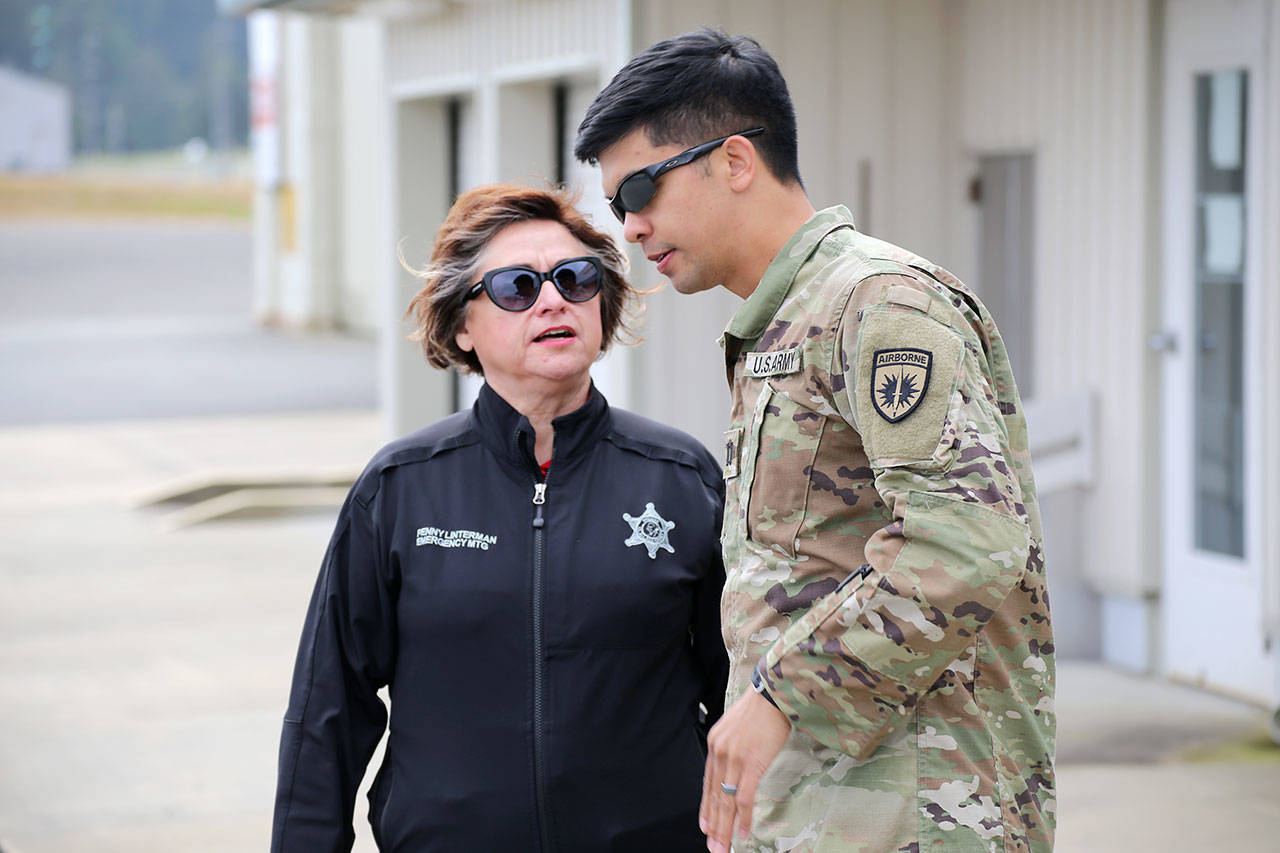PORT ANGELES — A massive earthquake would cut off key North Olympic Peninsula communications channels — but not for long, according to the results of a joint drill on emergency procedures.
The three-day exercise that began June 9 coordinated the Clallam County Emergency Management Section of the sheriff’s office, the Coast Guard and the Washington National Guard in preparation for a deadly quake and tsunami in the future.
One of the successes of the exercise was that the National Guard proved it was possible to airlift a Joint Incident Site Communications Capability (JISCC) unit to Port Angeles from Joint Base Lewis-McChord, set it up and talk with contacts at Camp Murray, in Spokane and in Canada.
“This demonstrates that we will be able to develop communications very quickly,” said Penny Linterman, program coordinator for the Clallam County Emergency Management Department.
“It’s reassuring to know that we will have something in a couple of days.”
In addition, ham radio operators were able to touch everyone within an hour, Linterman said, recognizing in particular Bruce and Kathleen Reiter, who are in charge of the local Amateur Radio Emergency Service (ARES) chapter.
About 75 people were involved, Linterman said — 45 from the National Guard and the rest volunteers.
Joining them June 10 were six officers from the Royal Thai Army, who came to Port Angeles to observe.
“These are men who are in charge of disaster relief in Thailand,” Linterman said. “They wanted to come here and see how we do things.”
This month’s drill built upon relationships forged during last summer’s Cascadia Rising exercise, said Capt. Dominique Calata, force protection plans officer, Special Operations Detachment-Pacific for the National Guard.
The regional Cascadia Rising drill was in preparation for the Big One on the Cascadia Subduction Zone, an 800-mile fault that stretches from southern British Columbia to Northern California. The fault spawns massive earthquakes an average of once every 200 to 500 years, with the last in about 1700.
Immediately following the onset of such a catastrophe, area residents most likely would have to look to themselves and their neighbors for help. The expectation is that telephone lines and roads would be heavily damaged or destroyed.
Cascadia Rising not only tested the Washington National Guard’s capabilities to respond to a major Cascadia Subduction Zone earthquake but also provided opportunities for relationship building across the state, Calata said.
That continued this month as Guardsmen from the Special Operations Detachment-Pacific, Joint Force Headquarters and 194th Wing continued to strengthen relationships with first responders in Clallam County, he said.
“We took part in a multi-faceted exercise with the Clallam County Sheriff’s Office to test our communications capabilities, food and supply distribution, search and rescue mission, moving the county Emergency Operations Center and most importantly continuing coordination with the first responders in the area,” Calata added.
Airlifting the JISCC, a system operated by both Air and Army National Guard personnel that makes it possible to bring communication capabilities to remote locations, was one of the major capabilities tested, he said.
The JISCC was airlifted to the William Fairchild International Airport in Port Angeles and set up along the runway.
“The unit was never really designed to be transported via air,” said Lt. Col. Mike Burk, deputy A6/J6, Joint Force Headquarters.
“However, last year’s Cascadia Subduction Zone exercise identified a need to be able to fly the capability to locations where there may not be cleared roads.”
The JISCC was a critical part in the communication’s exercise portion of the June drill weekend, as citizen-soldiers from the SOD-P traveled to Forks and Neah Bay areas, both of which could be hit the hardest on the Peninsula after a deadly tsunami.
The SOD-P, who is assigned to Homeland Security Region Two (Clallam, Jefferson and Kitsap County) coordinated the weekend’s event with Linterman.
“We want to continue to build that relationship with the Guard,” Linterman said. “It is critical that we continue to work together and rehearse. Being on the Peninsula, we could be cut off from everyone else in the event of a major earthquake.”
One thing that the county has been working on is establishing Community Points of Distribution (CPOD), a place the public goes to pick up emergency supplies following a disaster. Members of the Guard joined volunteers at the Clallam County Fairgrounds to set up the potential distribution area.
Still, it’s important to remember that help won’t be coming right away following a major disaster, she said. Residents in rural areas on the Peninsula need to be prepared to be two weeks ready — at a minimum.
Residents looking for help can download the Washington Emergency Management “2 Weeks Ready” brochure at https://mil.wa.gov/preparedness.

